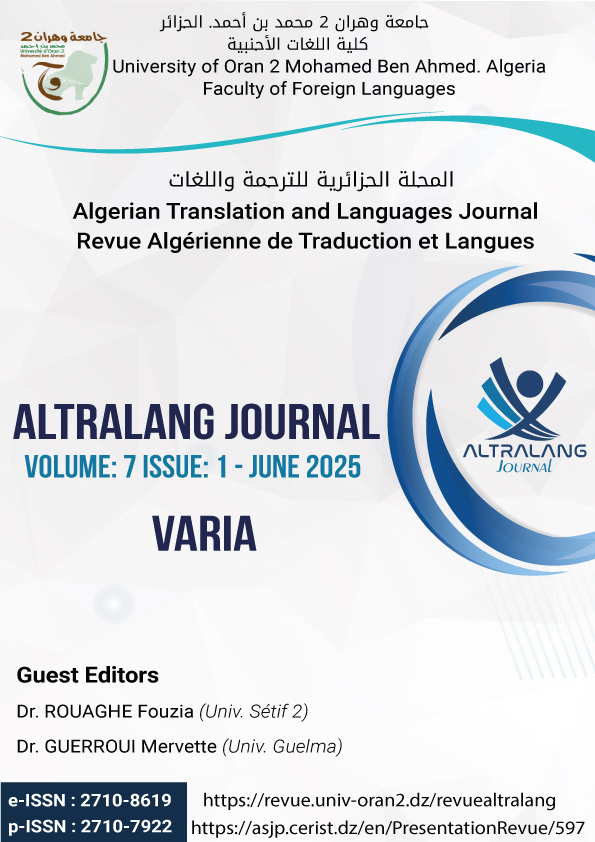From Traditional to Online Teaching and Learning: Major Reflections and Perceptions
Main Article Content
Abstract
Online teaching and learning undertakings are no longer considered as a nice-to-have extramural support but feedback about the context, the mode, the time people learn, and the source they learn it from. Digitization of education permits teachers and students to gain access to accredited data beyond the classroom, in a variety of systems and procedures that aid in exploiting time and space together. Teachers around the globe are struggling to rise above the shortcomings of being physically absent when shifting to online virtual learning platforms. This paper tries to uncover the viability of exploring technologies of education for the teaching/learning of English as a foreign language in the changing approach and perspective. The conclusions of this research are founded on replies to a questionnaire responded by a sample of undergraduate students of the English language department at Mohamed Ben Ahmed University of Algeria. Gen Z, the ‘digital natives’ reveal that they do not desire teachers to be replaced by computers as they require motivation, stimulation, and effective reinforcement. Virtual education is practicable, but its exploit is determined by the effective content structure, mulling over and anticipating this transition, and the flexible exploit of teaching/learning materials that can complement the exertions of the teachers. For virtual teaching and learning, not only do the schools and universities need to be well-appointed, but the learners too need to get to know the changing situation.
Article Details

This work is licensed under a Creative Commons Attribution 4.0 International License.
LICENSE: This work is licensed under a Creative Commons CC BY 4.0 license
References
• Benmansour, S. (2022). Google Meet during COVID 19 Pandemic: When Teachers Raise the Challenge. Arab World English Journal (AWEJ) 2nd Special Issue on Covid 19 Challenges (2) 169-182. DOI: https://dx.doi.org/10.24093/awej/covid2.11
• David, A.T. (2018).Synchronous Learning Vs Asynchronous Learning in Online Education”, available at http://the bestschools.org/magazines/synchronous vs asynchronous education/
• Dhawan, S. (2020). Online Learning: A Panacea in the Time of COVID-19 Crisis. Journal of Educational Technology Systems, 49(1), 5-22. https://doi.org/10.1177/0047239520934018
• Daymont, T., Blau, G., & Campbell, D. (2011). Deciding Between Traditional and Online Formats: Exploring the Role of Learning Advantages, Flexibility, and Compensatory Adaptation. Retrieved from Deciding between Traditional and_Online_20161001-31055-goal.pdf Dixit, S. (2020, July 5). Radio, Buddies & More: Alternatives for Students without Internet. Available at https://www.thequint.com/news/education/alternative-to-online-teaching-during-covid-19
• Fedynich, L, V. (2013). Teaching beyond the classroom walls: The pros and cons of cyber learning. Journal of Instructional Pedagogies, 13, 1-7. Retrieved from https://eric.ed.gov/?id=EJ1060090 https://www.turnitin.com/blog/evaluating-the-credibility-of-sources-in-the-age-of-covid-19
• Kang,M.,Kim,S&Kang,J.(2015).The predictive power of self regulalated learning ,teaching presence, and perceived interaction on theoutcomes of google plus-based project learning”, EdMedia+Innovate Learning. Association for the advancement of Computing in Education (AACE), pp.1444
• Kaur, N., & Bhatt, M. S. (2020). The Face of Education and the Faceless Teacher Post COVID-19. Journal of Humanities and Social Sciences Research, 2, 39-48. https://doi.org/10.37534/bp.jhssr.2020.v2.nS.id1030.p39
• Lander,G.(2014). “10 tips on how to use Google plus hangouts”, available at: http://www.jeffbullas.com/2013/12/04/10 tips- on- how -to- use- Google- plus- hangouts/.
• Melisa,S.(2020), “The impact of effective planning on teaching and learning process”, available at:http://www.projecttopics.org/ the-impact –of- effective- planning –on- teaching- and- learningprocess.htlm.
• Mishra, L., Gupta, T.,& Shree, A. (2020).Online teaching-learning in higher education during lockdown period of COVID-19 pandemic. International Journal of Educational Research Open, 2020. https://doi.org/10.1016/j.ijedro.100012.
• Pittman, J. S. T. (2021).An action research case study: digital equity and educational inclusion during an emergent COVID-19 divide, Journal for Multicultural Education, vol. ahead-of-print, no. aheadof-print. Retrieved from: https://doi.org/10.1108/JME-09-2020-0099
• Sarica, G., & Cavus, N. (2009). New trends in 21st Century English learning. World Conference on Educational Sciences 2009. Procedia Social and Behavioral Sciences, 1 439–445. www.sciencedirect.com
• Statt, N. (2017). “Google’s second Allo Messaging bot is an Al-driven GIF generator”, available at: http//www.theverge.com//1/25/14393380/googleallomessagingbot-luckyaigiftgenerator.
• Singh, V., T., & Hurman, A. (2019). How many ways can we define online learning? A systematic literature review of definitions of online learning (1988-2018). American Journal of Distance Education, 33(4), 289–306. https://www.tandfonline.com/doi/abs/10.1080/08923647.2019.1663082
• Srivastava, R . (2020). Unlocking Technology for Language Learning: A Viability at the Time of Transition from Traditional to Online Teaching and Learning. Arab World English Journal(AWEJ). Proceedings of 2nd MEC TESOLConference 2020. 96-110. DOI: https://dx.doi.org/10.24093/awej/MEC2
• Tichavsky, L. P., Hunt, A. N., Driscoll, A., & Jicha, K. (2015). “It’s Just Nice Having a Real Teacher”: Student Perceptions of Online versus Face-to-Face Instruction. International Journal for the Scholarship of Teaching and Learning, 9(2). Available at https://files.eric.ed.gov/fulltext/EJ1134532.pdf
• Wdowik, S. (2014). Using a synchronous online learning environment to promote and enhance transactional engagement beyond the classroom

1.png)